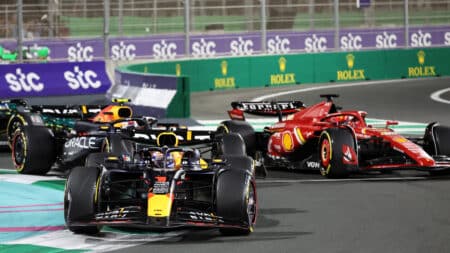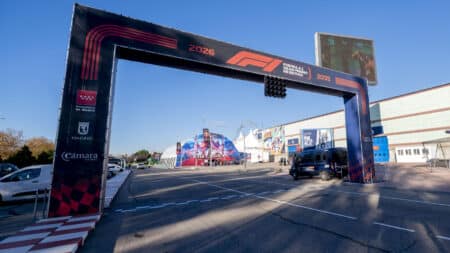
Which Red Bull will show up in Jeddah? - What to watch for at Saudi GP
Can Red Bull rebound from its poor Bahrain showing? And will it be Piastri or Norris leading McLaren's charge? Here's the five themes to watch for at the Saudi Arabian GP
With Giorgio Piola
The layout of this year’s Ferrari F14T has recently been uncovered, as these Giorgio Piola drawings show. What is revealed is a fairly radical car that was configured in an extreme way to maximise aerodynamic performance – even at the expense of power unit performance.
Central to the layout of the car has been the moving of the oil tank from the conventional place between the chassis and engine – a layout pioneered in the late ’90s by John Barnard’s Arrows and Alan Jenkins’ Stewart – to inside the gearbox casing. This has been done in order to move the engine as far forward within the wheelbase as possible which, together with increasing the wheelbase by around six inches over the 2013 car, has cleared space at the aerodynamically powerful lower rear of the car, potentially increasing the airflow capacity of the diffuser. Intercoolers nestle within the vee of the engine, allowing the sidepods to be narrower.
Although aerodynamically beneficial, the layout has prevented Ferrari from adopting the Mercedes-style split-turbo concept, whereby the compressor sits at the front of the engine with only the turbine at the rear, the two linked by a long shaft running through the vee of the engine. Using the Mercedes layout it has been possible to use a much bigger compressor than on the Ferrari (and Renault) engine where the size has been limited by not causing an airflow blockage in the aerodynamically sensitive rear ‘coke bottle’ area of the car.
The bigger compressor is at the heart of the Mercedes efficiency advantage over the Ferrari and Renault engines, allowing more power for a given fuel consumption. Now that the fuel consumption is effectively defined at each track by the fuel flow limit of 100kg/hour it means that Mercedes always has a substantial power advantage.
Furthermore, although the Ferrari F14T’s aerodynamic performance is believed to be quite respectable in isolation to the rest of the car, it appears still to be not the best in this area. In pre-season Bahrain testing Ferrari attempted to isolate its shortfall in pace by running the car disregarding the fuel flow limit in order to give approximate power parity with the Mercedes. In this form – which would be outside the regulations of a Grand Prix weekend – the car was only around 0.3s off the Mercedes rather than over one second when run to the regulation fuel flow limit. It indicated that although the power unit was responsible for more of the deficit than the aerodynamics, the aero was still lacking – a disappointing outcome when the concept of the car had been skewed in that direction, with compromises knowingly made on the power unit.

With no oil tank between the chassis and engine the hollow U-shaped area needed to accommodate it (arrow), allows the engine to be mounted further forward
Here we see the full secrets of the Ferrari’s layout:
1) Deeply stepped chassis at the front to enhance underbody flow.
2) Forward-sited engine which together with long wheelbase has allowed more extreme ‘Coca-Cola’ bottle sectioning of the rear bodywork, increasing airflow speed over the downforce-producing components of the whole car. The faster the airflow over these components, the greater the downforce. The more extreme the curvature of the ‘Coca-Cola’ section can be – without the airflow becoming detached – the faster the airflow will be accelerated. Having more length for the bodywork to narrow allows a more extreme ‘Coca-Cola’ section.
3) Moving the engine forward and increasing the wheelbase length has required a longer gearbox.
4) The wheelbase is around six inches longer than that of the 2013 Ferrari.

Ferrari used a combined joined turbine/compressor just like Renault which has turned out not to be the optimum solution for power and efficiency.

Gearbox comparison with the F14T’s being longer and containing the oil tank inside the case above the clutch space.

Comparison between the front of the Mercedes and Ferrari engines. The Mercedes, with its tall vertical oil tank in the conventional position between chassis and engine alongside the unconventional front-mounted compressor.

Stewart & Arrows: In 1998 one important revolution in the layout of F1 cars Alan Jenkins (Stewart) and John Barnard (Arrows) moved the oil tank from what was then the usual position inside the gearbox case (where Ferrari has re-sited it to this year) to the front of the engine in a position very close to the car’s centre of gravity, saving weight and doing a better packaging of all the pipes (extremely short). From the year after all F1 cars followed this trend until this year’s Ferrari.

Can Red Bull rebound from its poor Bahrain showing? And will it be Piastri or Norris leading McLaren's charge? Here's the five themes to watch for at the Saudi Arabian GP

McLaren's breakthrough in a near-four-year-old ruleset shows F1 rules convergence is a myth – just like Sebastian Vettel, Red Bull and Renault did in 2013, writes Mark Hughes

Madrid finally has a consortium to build the new Formula 1 circuit that will host the 2026 Spanish GP

Helmut Marko caused a stir after the Bahrain GP with his worries that Max Verstappen could leave Red Bull early. But how real are those fears?